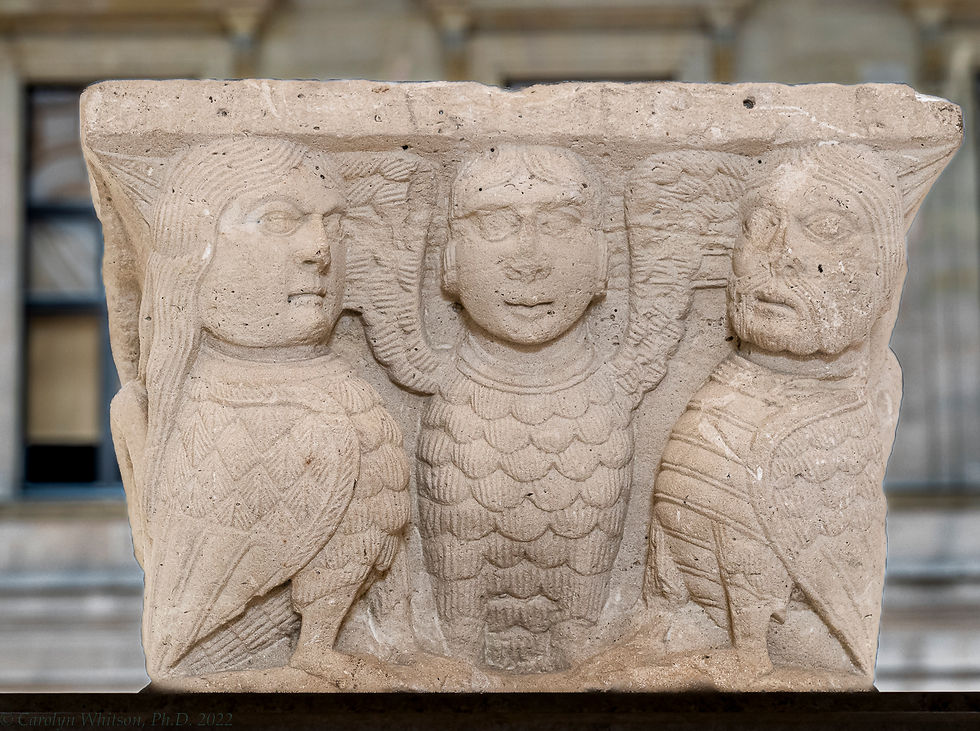Origins of Sirens
- Carolyn Whitson
- Nov 6, 2022
- 2 min read
Updated: Feb 13
On October 25th, 2022, I gave a lecture at Metropolitan State University on the Origins of Sirens. In the presentation, I trace how hybrid creatures in art arise in Mesopotamia, and how the creatures evolve in forms and meanings across the Mediterranean within a period of nearly 4000 years. At the end, I discuss the 19th-21st century depictions of mermaids, with an analysis of the current controversy caused by racist assertions that mermaid depictions in movies cannot be of any race except Caucasian.
I am placing the link to the lecture here, for your enjoyment. There is a transcript of the talk, in case you don't want to hear my voice for an hour (It was ragged due to a respiratory infection which has had me coughing for 9 weeks.). I'm including below many of the images I discussed. You can find ones of particular interest to you by scanning the course of the lecture for the image to pop up--they're in the same order as the lecture. I hope you enjoy it!

Here is the link to the lecture video: Origins of Sirens.
Capital, Plaimpied-Givaudin, 12th century

Capital, Musee Augustins, Toulouse, 12th century

Capital, Brioude, 12th century

Scylla, 5th c. BCE, Apuglia, Italy, Matera Archeological Museum (personification of the Straits of Messina)

Mosaic, Triton, 2nd c. CE, Seville Archeological Museum

Mosaic floor, Basilica of San Colombano, Bobbio, 12th century

Wood-carving, Troyes, approx. 16th century

Queen of Night, Southern Iraq, 19th-18thc BCE, British Museum

Bas-relief, Palace of Sargon II, Louvre, 8th c. BCE

Bas-relief, Adapa, servant of Enki/Ea, 7th c. BCE, Ninevah, Penn Museum

Expedition to Lebanon, bas-relief, 8th. c. BCE, Palace of Sargon II, Louvre

Apkallu, bas-relief, 8th.c. BCE, Assyria, Louvre

Tetramorph, 14th century, Parma Baptistry.

The Harpy Tomb, British Museum, 5th c. BCE, Xanthos

Sphynx, 6th c. BCE, Metropolitan Museum of Art

Vanth, cinerary urn, Volterra Etruscan Museum, 2nd century BCE

Vanth, or Medusa, 3rd c. BCE, Florence Archeological Museum

Olpe vase, 6th c. BCE, Greece, British Museum

Mosaic floor, 2nd c. CE, Roman, Getty Museum

Cerberus, 6th c. BCE, Italy, Louvre Museum

The Hope Hygeia, 2nd c. AD, Roman, Getty Museum

Harpy, 13th century, Souillac

Harpies, 12th c., Southern France, Louvre Museum

Siren, Sanguesa Iglesia San Maria la Real, 13th century

Mosaic floor, Otranto cathedral, 12th century

Entry at Moissac Abbey, 12th century

Abbey of Vezelay, 12th century

Autun Eve, 12th c., copy in Architectural Patrimony Museum, Paris

Salome, 12th century, Claustro San Pedro el Viejo, Huesca

Sens Cathedral, 12th century

Toledo Cathedral, misericord, 15th century

St. Pierre Cathedral, Poitiers, 13th century

Perrecy-les-Forges, 12th century,

Santa Maria di Uncastillo, 12th century.

Comments